|
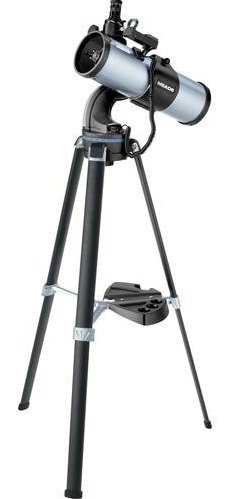 Since 2002 we have made a number of astronomical observation from the Kelston back garden using the Kelston Melchior telescope, named after one of the three Magi who are well known as keen observers of the stars. Since 2002 we have made a number of astronomical observation from the Kelston back garden using the Kelston Melchior telescope, named after one of the three Magi who are well known as keen observers of the stars.
Some of you may be interested to know that the Melchior telescope is a Meade DS-2114 reflecting telescope. And what is a reflecting telescope? It is just a cylinder with a bowl-shaped mirror at the back that gathers light and brings it to focus near the front of the tube where there is an eye piece (or a web cam) to look through. There are other telescope types available; perhaps the best known is the ‘spyglass’ or refracting telescope.
So what can one see from Kelston’s back garden, in the middle of a London suburb with plenty of light pollution? Amazingly enough, there are plenty of interesting things to see. We will start with the planets.
Planets
‘Planet’ is the Greek word for ‘wanderer’ and was given to the stars that seemed to always keep the same position relative to the others. Today, we know that planets are celestial bodies made of rock or gas, which do not emit light themselves but reflect light from a nearby star.
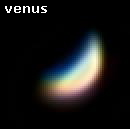 There are eight planets in the solar system, and all of them can be observed from the Kelston back garden. Five of them – Mercury, Venus, Mars, Jupiter and Saturn – can easily be seen with the naked eye. Perhaps you remember that a few years ago Pluto was considered a planet, but now it has been demoted to the ‘planetoid’ division. There are eight planets in the solar system, and all of them can be observed from the Kelston back garden. Five of them – Mercury, Venus, Mars, Jupiter and Saturn – can easily be seen with the naked eye. Perhaps you remember that a few years ago Pluto was considered a planet, but now it has been demoted to the ‘planetoid’ division.
Since Uranus and Neptune are very far away, little of them can be seen through the telescope and they just resemble stars of bluish-greenish colour. The rest of the planets may seem like stars when looked at with the naked eye, but with the help of the telescope we can see much more.
Venus
Venus is the planet that looks largest when seen from Earth, and the second brightest object in the night sky after the Moon. This picture of Venus was take late in 2008. Since the planet was low in the horizon, the picture is a bit blurred.
Mars
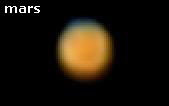 Mars is the red planet, named after the Roman god of war. It has a red hue, as the surface is full of iron-oxide minerals. Mars is the red planet, named after the Roman god of war. It has a red hue, as the surface is full of iron-oxide minerals.
Every two years Mars comes close to Earth, and some of the features of the surface become visible through the telescope. This picture of Mars was taken in December 2007. The bluish ‘tint’ at the top is the polar ice caps and the various shades of brown – just about visible – are surface features. Mars has a system of massive deep canyons that at some stage where thought by some astronomer to be canals.
Jupiter
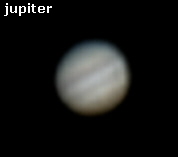 One of the most famous moments in astronomy was the discovery of the four biggest moons of Jupiter by Galileo Galilei in 1610. The four moons are called Io, Europa, Ganymede and Callisto. They rotate around Jupiter quickly enough that every night they can be seen in a different position. One of the most famous moments in astronomy was the discovery of the four biggest moons of Jupiter by Galileo Galilei in 1610. The four moons are called Io, Europa, Ganymede and Callisto. They rotate around Jupiter quickly enough that every night they can be seen in a different position.
Jupiter itself is the king of planets. It is named after the most powerful Roman god and is the biggest of all planets – although because it is far from the Earth it is not as bright as Venus which much smaller. Through a telescope, the bands of Jupiter can be clearly seen. These bands are a complex system of ammonia clouds resembling strips positioned across the disc of the planet. This picture was taken in September 2009, and the two central bands are clearly visible.
Saturn
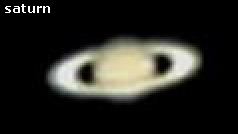 There is no doubt that this is the most amazing sight in the whole of the night sky. Many Kelstonians have had the chance to see it over the last few years. People are always surprise to see that you can actually see the rings very clearly. This is for two reasons one because their width is huge, the same as the distance between the Earth and the Moon, and, second, because they are made of small but highly reflective ice and dust particles. There is no doubt that this is the most amazing sight in the whole of the night sky. Many Kelstonians have had the chance to see it over the last few years. People are always surprise to see that you can actually see the rings very clearly. This is for two reasons one because their width is huge, the same as the distance between the Earth and the Moon, and, second, because they are made of small but highly reflective ice and dust particles.
This picture was taken in 2006 and is possibly the best one can do with the equipment we have. The rings are clearly visible, and the gap between the main systems of rings – the Cassini division – can just about be seen. The various colours of the Saturn atmosphere can also be seen, and the cloud system – not completely different from that of Jupiter- can just be made out.
The Moon
Earth’s only natural satellite is a very exciting target for telescope observations. Every day of its 28 orbit around the Earth brings different features, depending on where the line between light and shadow lies.
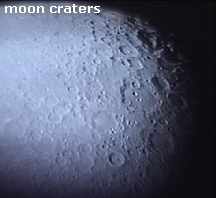 Craters within craters can be easily seen from the telescope. For some years people did not know whether the craters were due to meteorite impacts or two volcano eruptions. After the lunar landing, the mystery was solved and we now know that they are indeed impact craters. This picture shows one of the most heavily ‘cratered’ part of the moon with the prominent crater Clavius – the big one with several other craters inside – and the youngest lunar crater Tycho – the round crater with big shadows and a clear central spike towards the bottom of the picture. Craters within craters can be easily seen from the telescope. For some years people did not know whether the craters were due to meteorite impacts or two volcano eruptions. After the lunar landing, the mystery was solved and we now know that they are indeed impact craters. This picture shows one of the most heavily ‘cratered’ part of the moon with the prominent crater Clavius – the big one with several other craters inside – and the youngest lunar crater Tycho – the round crater with big shadows and a clear central spike towards the bottom of the picture.
To prove that Tycho is the youngest lunar crater, you just need to look at a full Moon, and you will see that ‘rays’ seem to spring in all directions from this crater, covering a good proportion of the moon. The rays are debris from the impact deposited all over the lunar terrain.
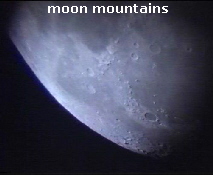 But there are more than craters in the Moon. The moon like the earth also has mountain ranges. This picture shows the range of lunar mountains called Apennines – named after the main mountain range in Italy. As you can see, it is surrounded by smooth terrain with fewer craters than other areas. Smooth means geologically young. It tells us that volcanic lava has resurfaced the covering of old impact craters. Unfortunately, the Moon has no active volcanoes any more, so there is no chance of seeing volcanic eruptions from the Kelston garden! But there are more than craters in the Moon. The moon like the earth also has mountain ranges. This picture shows the range of lunar mountains called Apennines – named after the main mountain range in Italy. As you can see, it is surrounded by smooth terrain with fewer craters than other areas. Smooth means geologically young. It tells us that volcanic lava has resurfaced the covering of old impact craters. Unfortunately, the Moon has no active volcanoes any more, so there is no chance of seeing volcanic eruptions from the Kelston garden!
Deep Sky Objects
In addition to planets and stars, there are other objects visible through the Melchior telescope: double stars, nebulae, cluster of stars, and galaxies. They are called deep sky objects because they are very far away, well beyond our solar system in the depths of space. Since they are distant objects – galaxies in particular – their light reaches us quite faintly, and it is difficult to observe them well in a relatively small aperture telescope like Melchior.
However, a peculiar object can be clearly seen during the winter. Near the three stars forming the ‘belt’ of the Orion constellation there is a cloudy patch just about visible with the naked eye. This is the famous Orion nebula, a gas cloud illuminated by a cluster of stars called The Trapeze – because there are four main stars arranged in a trapezoidal shape. Although the gas cloud looks grey when looked at through the telescope, a photo is able to reveal distinct colouring. This picture from the Melchior telescope was heavily processed on the computer afterwards to bring up as much colour as possible.
The Orion nebula is fascinating, and some years ago pictures from the Hubble Space Telescope were able to show us unseen new details of its structure.
|